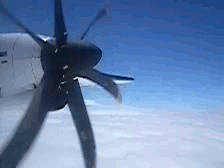vinyl LP front cover
Cover Design by Ronald Clyne
photo by Styrous®
On April 10, 1927, George Antheil presented the scaled-down version of his Ballet Mécanique at Carnegie Hall in New York City. It was the first symphonic work that used an airplane propeller and other mechanical contraptions not normally associated with the ballet.
The Ballet Mécanique was originally the score for a French Dadaist post-Cubist art film conceived, written, and co-directed by the artist Fernand Léger in collaboration with the filmmaker Dudley Murphy, with cinematographic input from Man Ray. Antheil himself was not a Dadaist, though he had many friends and supporters in that community.
Ballet Mécanique costume
By today's standards the film might seem funky and amateurish but
I
would imagine in the world of the twenties it was quite startling! The
music is visually exciting to watch being performed by an orchestra; if
you can, watch it full screen (link below)!
From Wikipedia:
In its original release, the film's French title was "Charlot présente le ballet mécanique" (as seen on the original print), referring to the Charlie Chaplin Little Tramp character as he was known in France. The image of a Cubist-style paper puppet of Charlot, by Léger, appears several times in the film. It is only the first of many visual puns in the film—a seeming display of the film's sheer visual modernity, as intended by its creators from the get-go.The Ballet Mécanique (1924) was originally conceived as an accompaniment for the silent film and was scheduled to premier at the Internationale Ausstellung neuer Theatertechnik. But before completion, director and composer agreed to go their different ways. The musical work runs close to 30 minutes, while the film is about 19 minutes long.In concert performance, the Ballet Mécanique is not a show of human dancers but of mechanical instruments. Among these, player pianos, airplane propellers, and electric bells stand prominently onstage, moving as machines do, and providing the visual side of the ballet.
As the bizarre instrumentation may suggest, this was no ordinary piece of music. It was loud and percussive – a medley of noises, much as the Italian Futurists envisioned new music of the 20th century.
The original orchestration called for 16 player pianos (or pianolas) in four parts, 2 regular pianos, 3 xylophones, at least 7 electric bells, 3 propellers, siren, 4 bass drums, and 1 tam-tam. As it turned out, there was no way to keep so many pianolas synchronized, so early performances combined the four parts into a single set of pianola rolls and augmented the two human-played pianos with 6 or more additional instruments.
In 1953, Antheil wrote a shortened and much tamer version (this reocrding) for four
pianos, four xylophones, two electric bells, two airplane propellers, timpani, glockenspiel, and other percussion. The complete version is on YouTube (link below).
Just in passing, there is a group, Twenty One Pilots, whose video for their song, Shy Away, from their album just released this year, Scaled and Icy, could very well have been influenced by the Cubist movement (link below).
And on a lighter note, there is the Australian children's music group, The Wiggles, which has performed the song, Do The Propeller, with Cookie Monster et al on Sesame Street; it's tons of fun to watch (link below).
The album also includes works by the Mexican composer, conductor, music theorist, educator, journalist, and founder and director of the Mexican Symphonic Orchestra. Carlos Chavez, as well as Alan Hovhanes and Ronald LoPresti; of the three, the Hovhanes piece, October Mountain, is quite amazing (links below)!
Tracklist:
Side 1:
Side 1:
A1 Ballet Mécanique
Composed By – George Antheil
Conductor – Robert Craft
Performer – Los Angeles Contemporary Music Ensemble
Composed By – George Antheil
Conductor – Robert Craft
Performer – Los Angeles Contemporary Music Ensemble
A2 Sketch For Percussion
Composed By – Ronald LoPresti
Conductor – Paul Price
Performer – Manhattan Percussion Ensemble
Composed By – Ronald LoPresti
Conductor – Paul Price
Performer – Manhattan Percussion Ensemble
Composed By – George Antheil
Conductor – Robert Craft
Performer – Los Angeles Contemporary Music Ensemble
Composed By – George Antheil
Conductor – Robert Craft
Performer – Los Angeles Contemporary Music Ensemble
A2 Sketch For Percussion
Composed By – Ronald LoPresti
Conductor – Paul Price
Performer – Manhattan Percussion Ensemble
Composed By – Ronald LoPresti
Conductor – Paul Price
Performer – Manhattan Percussion Ensemble
Side 2:
B1 Toccata For Percussion Instruments
Composed By – Carlos Chavez*
Conductor – Paul Price
Performer – Manhattan Percussion Ensemble
Composed By – Carlos Chavez*
Conductor – Paul Price
Performer – Manhattan Percussion Ensemble
B2 October Mountain
Composed By – Alan Hovhaness
Conductor – Paul Price
Performer – Manhattan Percussion Ensemble
Composed By – Alan Hovhaness
Conductor – Paul Price
Performer – Manhattan Percussion Ensemble
Credits:
Design [Cover Design] – Ronald Clyne
Liner Notes – Ann M. Lingg
Barcode and Other Identifiers
Matrix / Runout (A-Side Runout Etching): U 134 A1
Matrix / Runout (B-Side Runout Etching): Pc UR 134 B Tm-9214-B AB
George
Antheil* / Chavez* / Hovhannes* / Lopresti* – Ballet Mecanique /
Toccata For Percussion / October Mountain / Sketch For Percussion
Genre: ClassicalTwenty One Pilots
Style: Modern, Contemporary
Year: 1959
Genre: ClassicalTwenty One Pilots
Style: Modern, Contemporary
Year: 1959
Viewfinder links:
Net links:
Boston Modern Orchestra Project ~ George Antheil ~ A Jazz Symphony
George Antheil ~ Ballet Mécanique page
MOMA ~ Ballet Mécanique
SMCQ ~ Ballet Mécanique (1924, 53)
YouTube links:
George Antheil ~
Le Ballet Mecanique film (1924)
Carlos Chavez ~ Toccata For Percussion Instruments
Alan Hovhaness ~ October Mountain








No comments:
Post a Comment
PLEASE NOTE: comments are moderated BEFORE they are posted so DO NOT appear immediately.
Thank you.